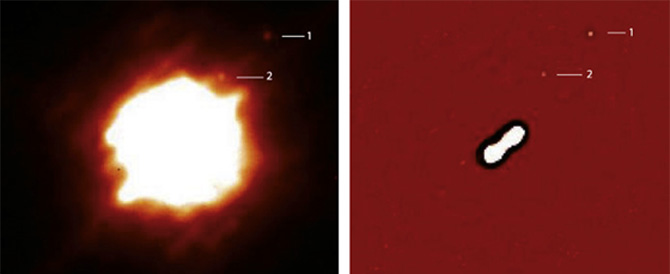Moons Around Asteroid Reveal a Giant Rubble Pile

Like the ancient Egyptian queen it was named for, the asteroid Kleopatra has birthed twins — a pair of moons that have helped scientists learn that the huge space rock is a rubble pile rather than a chunk of solid rock.
These two moons, named Alexhelios and Cleoselene after the twin children of the queen, were discovered in 2008. Now, astronomers studying their orbits have deduced that their parent asteroid is a jumble of loosely held rocks.
"That's the point of looking for triple and binary asteroids," study co-author Franck Marchis of the University of California, Berkeley told SPACE.com. "They're the only ones that allow us to measure the mass of the system." [See asteroid Kleopatra and its rocky moons]
Studying the asteroid system
Since the researchers knew Kleopatra's orbit, they were able to use data from various telescopes — including several operated by amateur astronomers — to observe Kleopatra as she passed between Earth and various bright stars.
They also used measurements from as far back as 1980 to examine other, similar passes. For each transit, they timed how long the star "winked" out of view from various positions on the planet. [Photos: Asteroids in Deep Space]
Because each location views the asteroid differently, combining these observations allowed the team to calculate the space rock's size and shape, as well as to view the moons and measure their orbit.
Breaking space news, the latest updates on rocket launches, skywatching events and more!
Having determined the orbits of Kleopatra's satellites, the team, lead by primary author Pascal Descamps of the Institut de Mecanique Celeste et de Calculs des Ephemerides (IMCCE) of the Observatoire de Paris, then was able to calculate the mass of the system as a whole.
With mass and size in hand, figuring out the asteroid's density was a breeze. The researchers concluded that the asteroid was not a solid rock.
"Our observations of the orbits of the two satellites of 216 Kleopatra imply that this large metallic asteroid is a rubble pile, which is a surprise," Marchis said in a statement.
The team reported its results in the February issue of the journal Icarus.
Big asteroid surprise
There are a number of smaller asteroids throughout the solar system that are loose, gravitationally bound piles of rock rather than solid objects.
But to find one in such a large system is surprising. At about 135 miles (217 km) in length, Kleopatra is among the largest of these rubble pile asteroids discovered over the past few years, topped only by 174-mile (280 km) 87 Sylvia.
"You expect something (this size) to be less porous," Marchis told SPACE.com.
In fact, given the density of its likely primary iron components, Kleopatra is between 30 and 50 percent empty space.
The rubble pile structure of the asteroid provides clues to its formation, as well as that of its satellites, researchers said. The collision of two larger, rocky asteroids likely resulted in the destruction of one, and the resulting rubble was held together by gravity.
As the pile continued to spin, it slowly shed mass, including its two moons. The outermost moon, Alexhelios, likely spiraled out around 100 million years ago, while the inner moon, Cleoselene, began its journey within the last 10 million years.
Kleopatra was discovered in 1880. Astronomers used stellar transits to determine it was elongated, but it wasn't until 2000 that it was revealed to be shaped more like a dog bone than a cigar. Descamps' team wanted to study whether the bulges at the end were connected to the body of the asteroid or were separate pieces entirely.
The team continues to study other binary or triple asteroid systems, but the tools that allow them to do so are limited.
"The only telescope in the world that can detect these (types of systems) is the Keck, because it has the largest aperture and the best AO (adaptive optic) system," Marchis said.
However, thousands of astronomers vie for the use of the largest optical and infrared telescope. Marchis expressed his hope that more telescopes like the 33-foot (10-meter) giants in Hawaii will be built, allowing more research to be done.
Follow SPACE.com for the latest in space science and exploration news on Twitter @Spacedotcom and on Facebook.
Join our Space Forums to keep talking space on the latest missions, night sky and more! And if you have a news tip, correction or comment, let us know at: community@space.com.

Nola Taylor Tillman is a contributing writer for Space.com. She loves all things space and astronomy-related, and always wants to learn more. She has a Bachelor's degree in English and Astrophysics from Agnes Scott College and served as an intern at Sky & Telescope magazine. She loves to speak to groups on astronomy-related subjects. She lives with her husband in Atlanta, Georgia. Follow her on Bluesky at @astrowriter.social.bluesky
